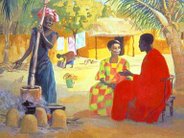Is this the end?
 The online British newspaper The Guardian recently published an article called This is the End, which chronicles the making of an incredible set of black and white photographs taken by German photographer Walter Shels and his partner Beate Lakotta. The photos are arranged in pairs, one taken just before the subject died, and one just after; they are accompanied by short interview-based captions that reveal a bit about how each person experienced their impending death.
The online British newspaper The Guardian recently published an article called This is the End, which chronicles the making of an incredible set of black and white photographs taken by German photographer Walter Shels and his partner Beate Lakotta. The photos are arranged in pairs, one taken just before the subject died, and one just after; they are accompanied by short interview-based captions that reveal a bit about how each person experienced their impending death.
The photos are beautiful, poignant, and astonishing. Like the photographer, I found all my fears related to death bubbling to the surface as I stared into the faces -- some peaceful, some angry, all serious -- of his subjects. I wondered how the bodies had been prepared for the photo session. I wondered how I would have reacted as a photographer, an interviewer, or the person interviewed. I marveled at the subtle differences in the pairs of photos. I drew out my understanding of death and examined it once again. And most of all, I thought about God's role in this.
When I went to Digg, a prominent social bookmarking site, to give the photo set my vote of approval, I was drawn in to the strong reactions shown in the comments. A few of the commentors reacted with poor jokes, profanity, and irritation. Some commented on the mystery surrounding the photos and our reaction to them. Many were moved, many frightened. But the reaction that interested me the most was the one in which a conservative Christian used the comments section to preach a short, bible-thumping sermon to all the viewers.
Digg members have the ability not only to vote approval/disapproval on internet articles and sites, but they also register their approval/disapproval to other people's comments. The user called "Indyanna" who posted the sermon was by far the most disliked, drawing a spate of negative "diggs" and comments. Even I was frustrated by Indyanna's inability to understand the situation and respond appropriately.
So I began to think: What would be the best way for Jesus people to talk about this on the internet, in the middle of the whirl of fear, discomfort, and anger that frequently surrounds the topic of death and dying? There's by no means an easy answer. But my first thought is that maybe we should have less to say and more to do. Maybe Jesus people are called to listen before we storm in with our sermons. Listen, sympathize, and really strive to understand where people are coming from. And maybe we've done so little of that over the years that I can't formulate a second step yet.
Go and view the photos yourself. What do they bring up for you? I invite you to share your comments here. I will be honored to listen.

4 comments:
This was wonderful. My favorite quote was from the woman who said, "And I’d only just bought myself a new fridge-freezer! If I’d only known!"
Very interesting project. I was struck by the folks who seemed surprised that death was coming- or- lived with the idea that it wouldn't happen until they were old or ready for it.
Good reminders to live in the present.
Also, I noticed the fact that the photographer had styled the hair of the ladies after they passed. It said something to me about the dignity of human beings.
Growing up, one of my dad's best friends owned a funeral home. He ran the town ambulance as well, kind of a weird combination.
I can't say how many people he saw living and then watched them die.
It always messed with him a bit, he hid it with comedy and other facades. I always wondered how he really dealt with that. It would be easy to just believe they were in heaven and not think about their life, but in a small town he know most of the bad stuff about people.
So I guess for me, these photos conjured up a sterile feeling for the dead. The absence of the soul is really captured in these.
Great Post BTW!
There used to be a tradition in many cultures, some of which settled in the US, to keep a book of the dead. They had photographic portraits made of people in the family after they passed. These were pretty uncommon after early 20th century, but our family was one of those who had pictures of people in caskets or on their beds after they were gone. In fact, even in some contemporary deaths photos are placed around the casket of the person alive, and photos are taken of the body and shared with people who couldn't attend.
I really enjoyed this series, and I wonder if this isn't more of a return to something than a whole new thing. A return to authenticity? A rejection of denial? Don't know. I know that I'm not creeped out by these in the least, and find it an act of completion, in a sense, to close the circle.
Post a Comment